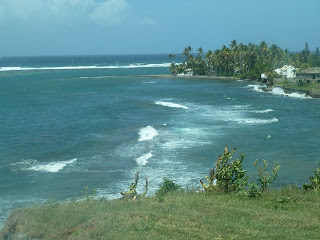Basseterre, St Kitts, the lesser Antilles.Thursday 28/04/2011
Christopher Columbus’s colossal St Kitts!
Christopher Columbus sailed past this beautiful island in 1492, he returned in 1493 and named the island St Christopher after his patron saint. Today it is known as St Kitts! Before Columbus came here indigenous tribes had been living here for two millennia. Their influence, as well as the French, British and Spanish colonizers is evident in Basseterre and around the island.
St Kitts gained independence in 1966 and this 68 sq mile volcanic island with a population of 48,000 is a credit to its residents who are very proud of their island and their heritage! It has been our favourite island. It’s clean, tidy, the people are happy and friendly and Gloria, our excellent taxi driver, drove us around the whole island explaining the sights and highlights, the islands history, their current day situation, and about their traditional food and everyday life. Nevis is St Kitts sister island, a 30 minute ferry ride away. Both islands are dominated by volcanic mountains which sit proudly and preside over these beautiful islands and provide a stunning scene as you approach and leave the islands as well as drive around them. The Verchilds Mountain, Olivee’s Mountain and Mt Liamuiga (3,792 ft ) - the highest point in the Lesser Antilles chain of islands - sit atop St Kitts. Nevis Peak (3,232 ft) is the towering centre piece of Nevis.
We disembarked at Fort Zante, which is reclaimed land, where they have built Caribbean style Duty Free Shops, bars, restaurants and cafes. Behind is Basseterre, the capital, and the oldest town in the eastern caribbean where elements of French and British colonization have been carefully preserved. The central square of the town has the Circus Clock, designed in Victorian architectural style and nicknamed after Piccadilly Circus in London. The English and French came to an interesting agreement regarding St Kitts and shared the island for some years - the French occupying the two ends of the island and the British the middle section. Independence Square is a beautiful Park in town and is represents the end of slavery on the island. A reminder of the days when it was a slave market is around the square with the Georgian-style houses of the planter class still there, as well as the building that held the slaves until they were bid for on market day and then taken to work on the sugar plantations.
The island is broken into parishes and each has its own church. The main religion on the island is Anglican.
Sugar was the basis of its economy until tourism took over. As we travelled around the island there is much evidence of the old sugar plantations with ruins and stacks all over the island, as well as some of the old plantation homes and manors preserved as hotels and restaurants for all to enjoy. There are still sections of land where the sugar cane grows wild. Farming is difficult on the island. While the government give the people the land to farm the monkeys on the island devastate any crops that are planted. They are trying to rid the island of the destructive monkeys so the government has allowed the residents to use them as meat. Like other islands in the caribbean they import a lot of their produce from Dominica.
We saw prominent Brimstone Hill Fortress and National Park (know as he Gibraltar of the West Indies), a UNESCO World Heritage Site. The fortress sits a top 38acres of limestone and sulphur composites (you can smell the sulphur as you drive past!), and is the result of 100 years (began in 1690) of slave labour and has endured many wars fought between the English, French and Spanish troops for its control.
We crossed over Bloody Point, near the village of Challengers, where indigenous Caribs were massacred.
Romney Manor (a former sugar estate) and its 12 acre botanical paradise was lovely!- the magnificent 350 yr old Saman tree is the central feature of the garden. It was really interesting to see the ladies at Caribelle Batik Studio, which is part of the manor, producing their beautiful batik. Samuel Jefferson ( great-great-great grandfather to S President of Thomas Jm,imm jm nv/,efferson) owned this estate. He, and one of the original English settlers and first governor of the island, Sir Thomas Warner, are buried in the first Anglican Church built in the British Caribbean - St Thomas Anglican Church, Middle island
From Timothy Hill lookout we had an amazing view of the Frigate Bay area and across to Nevis. We had the Atlantic with its great deep blue surf (the Aussie board riders would have loved the big surf here today!) on our left and the calm green of the Caribbean on our right. Spectacular! This area is where all the tourist hotels and the night life area they call “The Strip” nestle.
Thanks for the wonderful day Gloria! Gloria was the best guide we had on this trip - she was friendly, interesting and very informative about all aspects of the heritage and the life on St Kitts.
A tip for sightseeing while cruising. The cruise lines always offer onshore excursions - while they are good and certainly the choice of some people, we found that when you get ashore there are local taxi’s accredited by the island’s government or tourist agency that you can hire for half the cost to do your sightseeing with.
“The Music of Neil Diamond” with the fabulous Jose and Patti topped off a great day.










































No comments:
Post a Comment